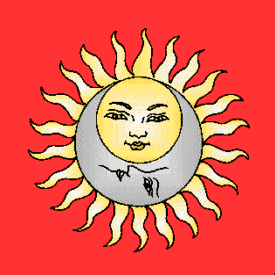

This tradition went through many phases and schools over this period of time, ranging from an extremely heterodox viewpoint to, in some cases, a very orthodox standpoint. Here we concentrate on the Kaula tradition in many of its guises. The work kaula is cognate with clan and the communities venerated a huge number of gods (devas) and goddeses (devis).
On this large Web site you will find yantra, mantra, tantra and other material relating to the tantrik tradition; texts on the siddhas and yogis of the Natha sampradaya including Gorakhnath, Matsyendranath and Dattatreya; much about kundalini, nadis, chakras; images of tantric kula devas (gods) and devis (goddesses) including Kali, Tripura, Shiva, Ganesha, Cchinnamasta, Durga and Tara; pujas and practices; meditations and dharanas; the inner meaning of kaulachara, vamachara and svecchacharya; an extensive bibliography, and original English translations as well as links to other sites.
Although some tantras appear straightforward, most, if not all of them, employ a type of language which can be taken on many levels. According to the tradition, everything has a gross, a subtle and a supreme meaning and as the Devi is the goddess of letters, she can bewilder with her Maya as well as enlighten.
Many terms used in the tantrik tradition have meanings which can be taken at face value but do not always have this meaning, thus making them difficult to understand to the literally-minded. The mentality of the pashu, or a person with a herd-disposition, is said to predispose him or her to misunderstand the meaning.
This cryptic way of speaking pervades many of the texts. Should a cremation ground, for instance, be understood as the yoni, as the real place where corpses are burnt, or as a symbol for the Absolute? The answer may be all three. Is a crossroad a symbol of the five elements, the place where roads meet, or four centres within the human body? Again, it may have one or any of these meanings. And is the union of Shiva and Shakti the symbol of sexual intercourse, the union of vital breaths within the body or an eclipse?
We can probably find the answers to these questions by going to the root philosophy of the tantrik traditions. There is no Shiva without Shakti and yoga is a realisation of the unity of all things. That is not to say that everything in tantrik texts is figurative; many describe practices which are said to bring about this realisation.
It is also important to remember that legends and stories within the tradition may be intended to appeal to parts of the human mind which are not solely connected with logic.
For example, in the Tripurarahasya (secrets of Tripura), a wonderful work available in an English translation (see Bibliography), much of the teaching and practical philosophy of the tradition is told in story form, easy to digest but pregnant with meaning. Bear these considerations in mind when browsing this site.
If you are new to the subject, we suggest you visit the glossary page, where many of the terms on this site are explained in a simple manner. The headings below each open out into sub-pages where you can sample many of the mysteries of this ancient tradition.
The sections and the topics in the frame left also need some explanation. Very broadly speaking, tantras fall into traditions belonging to greater or lesser schools. The Kali tradition, for example, has a large literature and there are specific areas in India where her worship is concentrated. The Lalita, or Shri Vidya tradition, has a very extensive literature, much of which is still unplumbed.
The Natha Sampradayas or lines relate to sects said to have originated mostly from Matsyendranath and Gorakhanath, and occupy an important position in the yoga schools of the mediaeval period.
Under other topics, we have included a selection of tantrik topics, each of which could form vast topics on their own.
Tantrik ritual is included because above all else the adepts of these schools insisted on practical work. Many tantras are practical manuals and this section will be expanded in the future.
We have also included some translations of parts of the tantrik literature along with abstracts of other texts to give a feel for the whole subject. If there are mistakes in the translations, please forgive us.
The Sanskrit texts section will also be expanded in the future to include material hard to find, out of print and also out of copyright.
Because the tantrik tradition still lives on in the last years of this millenium, we have also included material written by HH Shri Gurudev Mahendranath, the 23rd guru of the Adinatha Sampradaya, who died just a few years ago.
Suggestions and comments about the site are very welcome at the email address below.
Tantrik Goddesses
Points to Kali, Lalita, Shri Vidya, Jvalamukhi, Cchinnamasta, Bala
and many other Devis. Sample here
the beautiful symbolism of Lalita, the terrifying natures of
Kali and Cchinnamasta, yantras and other secrets of the
goddesses.
Tantrik Ritual
This section points to information about the Gayatri mantra,
rosaries, daily
worship, the materials for making yantra and much more. (Under
construction)
Yoga and the Nathas
Links to yoga images, Gorakhnath, Matsyendranath and ancient texts.
View here
the symbolism of Dattatreya, the nature of the 35 tattvas and much
more.
Glossary: Translations: Bibliography
Includes a comprehensive explanation of tantrik terms, further
reading, many original English translations.
Links
A wide range of links to other tantrik and hindu sites plus FTP
access.